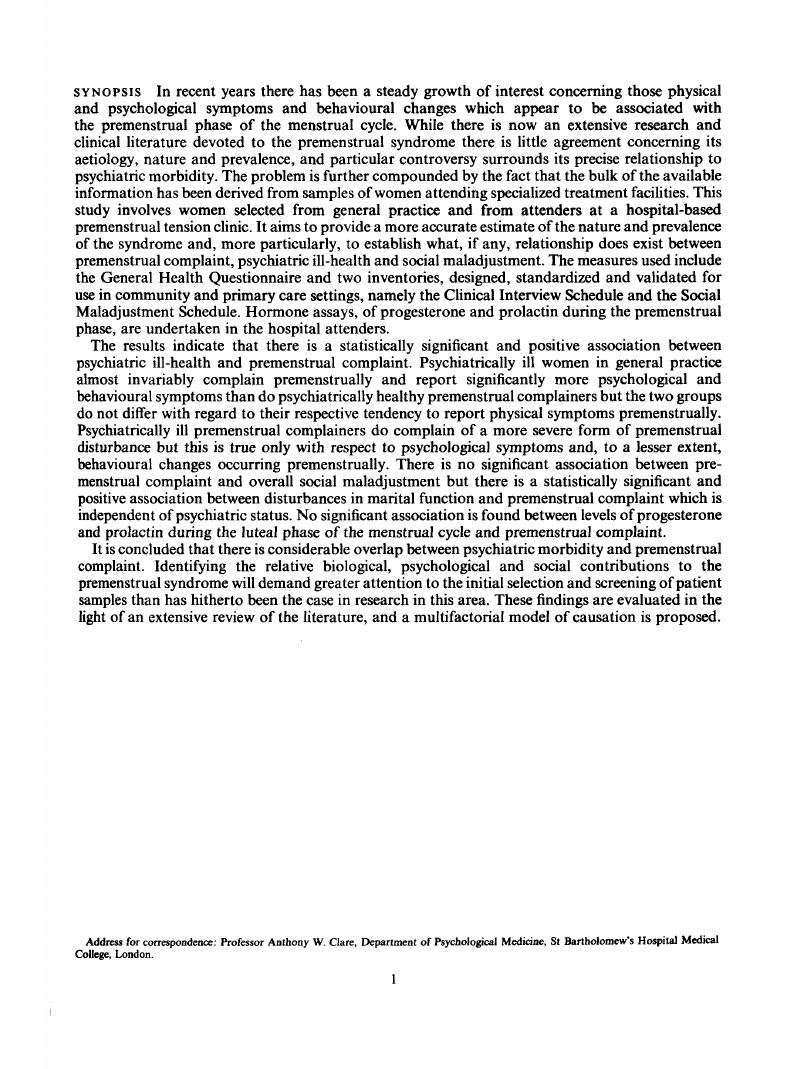Crossref Citations
This article has been cited by the following publications. This list is generated based on data provided by Crossref.
Clare, Anthony W.
1985.
Invited review hormones, behaviour and the menstrual cycle.
Journal of Psychosomatic Research,
Vol. 29,
Issue. 3,
p.
225.
van den Akker, Olga
and
Steptoe, Andrew
1985.
The Pattern and Prevalence of Symptoms During the Menstrual Cycle.
British Journal of Psychiatry,
Vol. 147,
Issue. 2,
p.
164.
Williams, Melanie J
Harris, Raymond I
and
Dean, Bernard C
1985.
Controlled Trial of Pyridoxine in the Premenstrual Syndrome.
Journal of International Medical Research,
Vol. 13,
Issue. 3,
p.
174.
Hart, William G.
Russell, Jon W.
and
Coleman, Grahame J.
1987.
Psychiatric screening in the premenstrual syndrome.
Medical Journal of Australia,
Vol. 146,
Issue. 10,
p.
518.
Dalton, Katharina
1987.
Premenstrual Syndrome.
p.
287.
O’ Brien, P. M. S.
1987.
Premenstrual Syndrome.
p.
317.
Haskett, Roger F.
1987.
Premenstrual dysphoric disorder: Evaluation, pathophysiology and treatment.
Progress in Neuro-Psychopharmacology and Biological Psychiatry,
Vol. 11,
Issue. 2-3,
p.
129.
Ames, Natalie
1988.
One More Look at PMS: Implications for Women of a New Focus on an Old Problem.
Health Education,
Vol. 19,
Issue. 2,
p.
48.
Donovan, Bernard T.
1988.
Humors, Hormones and the Mind.
p.
257.
Mauri, M.
Reid, R. L.
and
MacLean, A. W.
1988.
Sleep in the premenstrual phase: a self‐report study of PMS patients and normal controls.
Acta Psychiatrica Scandinavica,
Vol. 78,
Issue. 1,
p.
82.
Gath, D.
and
Iles, S.
1988.
Treating the premenstrual syndrome..
BMJ,
Vol. 297,
Issue. 6643,
p.
237.
Slade, Pauline
1989.
Psychological Therapy for Premenstrual Emotional Symptoms.
Behavioural Psychotherapy,
Vol. 17,
Issue. 2,
p.
135.
Hammarbäck, S.
Bäckström, T.
and
Macgibbon-Taylor, B.
1989.
Diagnosis of premenstrual tension syndrome: description and evaluation of a procedure for diagnosis and differential diagnosis.
Journal of Psychosomatic Obstetrics & Gynecology,
Vol. 10,
Issue. 1,
p.
25.
Hunter, Myra
1989.
Health Psychology.
p.
312.
Sampson, Gwyneth A.
1989.
1 Premenstrual syndrome.
Baillière's Clinical Obstetrics and Gynaecology,
Vol. 3,
Issue. 4,
p.
687.
Osborn, M. F.
and
Gath, D. H.
1990.
Psychological and physical determinants of premenstrual symptoms before and after hysterectomy.
Psychological Medicine,
Vol. 20,
Issue. 3,
p.
565.
Taghavi, Ebrahim
1990.
Premenstrual Syndrome in Three Generations Responds to Antidepressants.
Australian & New Zealand Journal of Psychiatry,
Vol. 24,
Issue. 2,
p.
276.
Bäckström, Torbjörn
and
Hammarbäck, Stefan
1991.
Premenstrual Syndrome—Psychiatric or Gynaecological Disorder?.
Annals of Medicine,
Vol. 23,
Issue. 6,
p.
625.
Kendler, K. S.
Silberg, J. L.
Neale, M. C.
Kessler, R. C.
Heath, A. C.
and
Eaves, L. J.
1992.
Genetic and environmental factors in the aetiology of menstrual, premenstrual and neurotic symptoms: a population-based twin study.
Psychological Medicine,
Vol. 22,
Issue. 1,
p.
85.
Howard, Rick
Mason, Patsy
Taghavi, Ebrahim
and
Spears, George
1992.
Brainstem auditory evoked responses (BAERs) during the menstrual cycle in women with and without premenstrual syndrome.
Biological Psychiatry,
Vol. 32,
Issue. 8,
p.
682.





